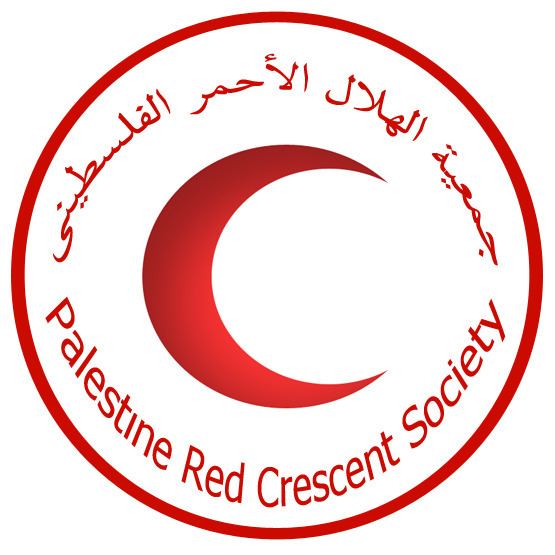Formation 1968 Headquarters al-Bireh | Type Non-profit Website [2] | |
 | ||
Region served Palestinian territories | ||
The Palestine Red Crescent Society was founded in 1968, by Fathi Arafat, Yasser Arafat's brother. It is a humanitarian organization that is part of the International Red Cross and Red Crescent Movement. It provides hospitals, emergency medicine and ambulance services, and primary health care centers in the West Bank and Gaza Strip. Its headquarters is based in Ramallah, near Jerusalem. It is an observer member of the International Falcon Movement - Socialist Education International
Contents
- Ambulance services
- Special problems
- Palestine Red Crescent Society in Hebron
- PRCS specialized hospital
- EMS Center
- Emergency Clinic
- Disaster Preparedness Team
- Al Rajaa center for special education
- Physiotherapy center
- Mobile Rehabilitation clinic
- Community based Rehabilitation CBR
- Psychosocial support Center
- Educational Services
- References
The PRCS was officially recognized by the ICRC and IFRC in June 2006, in a move that also recognized the Israeli Magen David Adom and the politically neutral Red Crystal symbol.
Ambulance services
The PRCS provides the majority of ambulance services in the territories, such as providing emergency medical and relief services to Palestinians as mandated in 1996 by then PLO leader Yasser Arafat. Ambulance services are provided by 41 stations and substations, 22 mobile field posts, 122 ambulances, 346 Emergency Medical Technicians (EMTs) and over 500 volunteers.
1996 also saw the foundation of the Emergency Medical Institute, which trains staff and EMTs in accordance with international standards. Furthermore, the PRCS has been instrumental in the establishment of the national emergency number (101).
Special problems
Conflict between Israelis and Palestinians has created some special issues for service delivery.
According to Israeli sources, there have been numerous incidents in which Palestinian ambulances have been found transporting bombs, missiles, or terrorists disguised as patients. As such, the Israel Defense Forces (IDF) has a policy of stopping to inspect all Palestinian ambulances at roadblocks, regardless of the seriousness of the patient's condition.
According to the PRCS, Israeli Defense Force personnel on the ground and in aircraft have deliberately targeted Palestinian ambulances, and prevented or impeded them from carrying out their duties, in violation of international humanitarian law. In 2003, for example, the PRCS reported that seven staff members were injured and 12 ambulances were damaged in attacks by Israeli settlers and the IDF, and PRCS ambulances were denied or delayed access to areas on 584 different occasions.
During the 2008–2009 Gaza War, Amnesty International rejected charges by Israel that Hamas had systematically used medical facilities, vehicles and uniforms as a cover, stating that no evidence had been provided proving such actions. Further, Magen David Adom's submission to the UN Mission investigating the war stated that, "there was no use of PRCS ambulances for the transport of weapons or ammunition ... [and] there was no misuse of the emblem by PRCS."
Palestine Red Crescent Society in Hebron
PRCS Hebron Branch was established in 1965 with a view to providing health, social and academic services to Palestinians as well as to promoting health and social conditions of Palestinians in the southern West Bank through several programs and the following services:
Health services
PRCS specialized hospital
This building comprises eight stories (470 meters each). A 4500 m2 piece of land adjacent to the hospital was bought and shall accommodate hospital facilities and a comprehensive health complex. The hospital shall comprise the following sections: 1- An EMS section (6 beds); 2- Pediatric microsurgery and child care section (22 beds); 3- Medium pediatric care (12 beds); 4- Neonatal ICU section (6 beds); 5- Gynecology, obstetrics and fertility section (12 beds); 6- General surgery section; 7- Backstopping medical sections, including a lab, x-ray services, external clinics, a pharmacy, a medical engineering section and medicine warehouses.
Project progress
All hospital floors have been built and finished. The following sections have been inaugurated: 1. External pediatrics clinics, including:
2. Ordinary child care section (12 beds). 3. Neonatal ICU 4. Gynecology and obstetrics 5. Backstopping medical sections including lab, pharmacy and x-ray services.
Work is ongoing to equip and operate the following sections: 1- Pediatric microsurgery section (22 beds); 2- Pediatric ICU section; 3- General Surgery section
EMS Center
Emergency Clinic
Disaster Preparedness Team
Al Raja’a center for special education
Established in 1985, the center provides care for mentally disabled children aged 6 to 18. It focuses on children suffering from mild and moderate mental retardation who respond to learning and rehabilitation, with a view to making them active and productive and integrating them in the labor market, whether in professional workshops in the center or in local factories and institutions. More than 100 students with special needs are enrolled in the center under the supervision and care of 24 skilled staff. A branch of the center was inaugurated in Tarkoumia to cater to the needs of residents in areas to the west of Hebron Governorate who do not have easy access to the main center in Hebron. 43 students are currently enrolled in this center. A second floor (900 m2) was built in the center with support from the Spanish Cooperation Agency.
Center sections:
Educational section. It comprises:
Professional section. It comprises:
Physiotherapy center
The center is adjacent to the EMS building. It provides services free-of-charge to the needy, the injured and families of Palestinian martyrs and detainees.
Mobile Rehabilitation clinic
Community-based Rehabilitation (CBR)
Psychosocial support Center
Objectives:
Educational Services
Kindergarten
The branch operates two kindergartens with 120 children and provides transportation from and to their homes, as follows:
Youths and Volunteers Department and Community Center
As voluntary action constitutes one of PRCS’ main pillars, the branch depends on volunteers for support. It also helps polish their skills and build their capacities.
The Department and the Community Center target the local community at large (men, women, children, youths, elderly persons and persons with special needs), with particular focus on young people.
